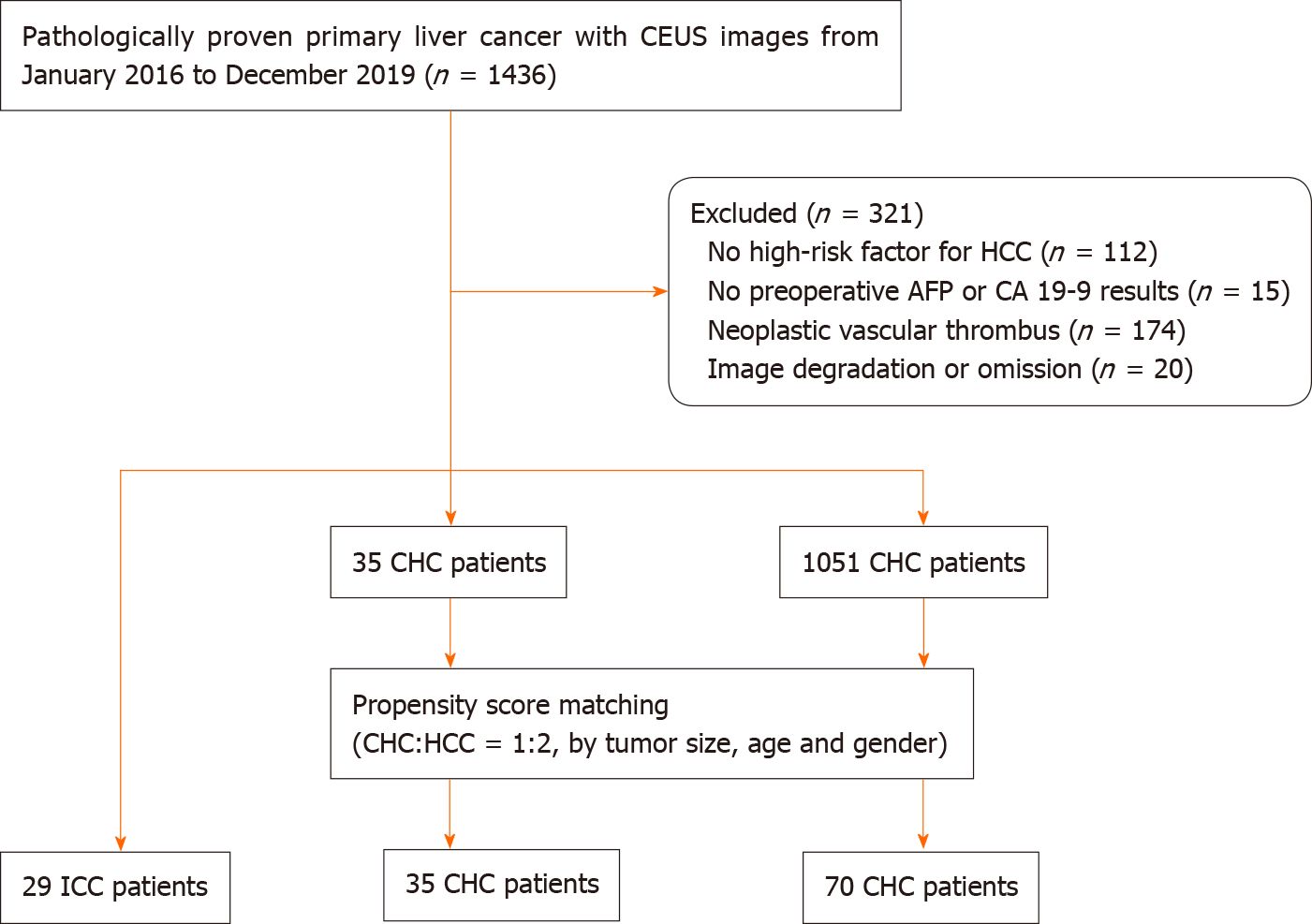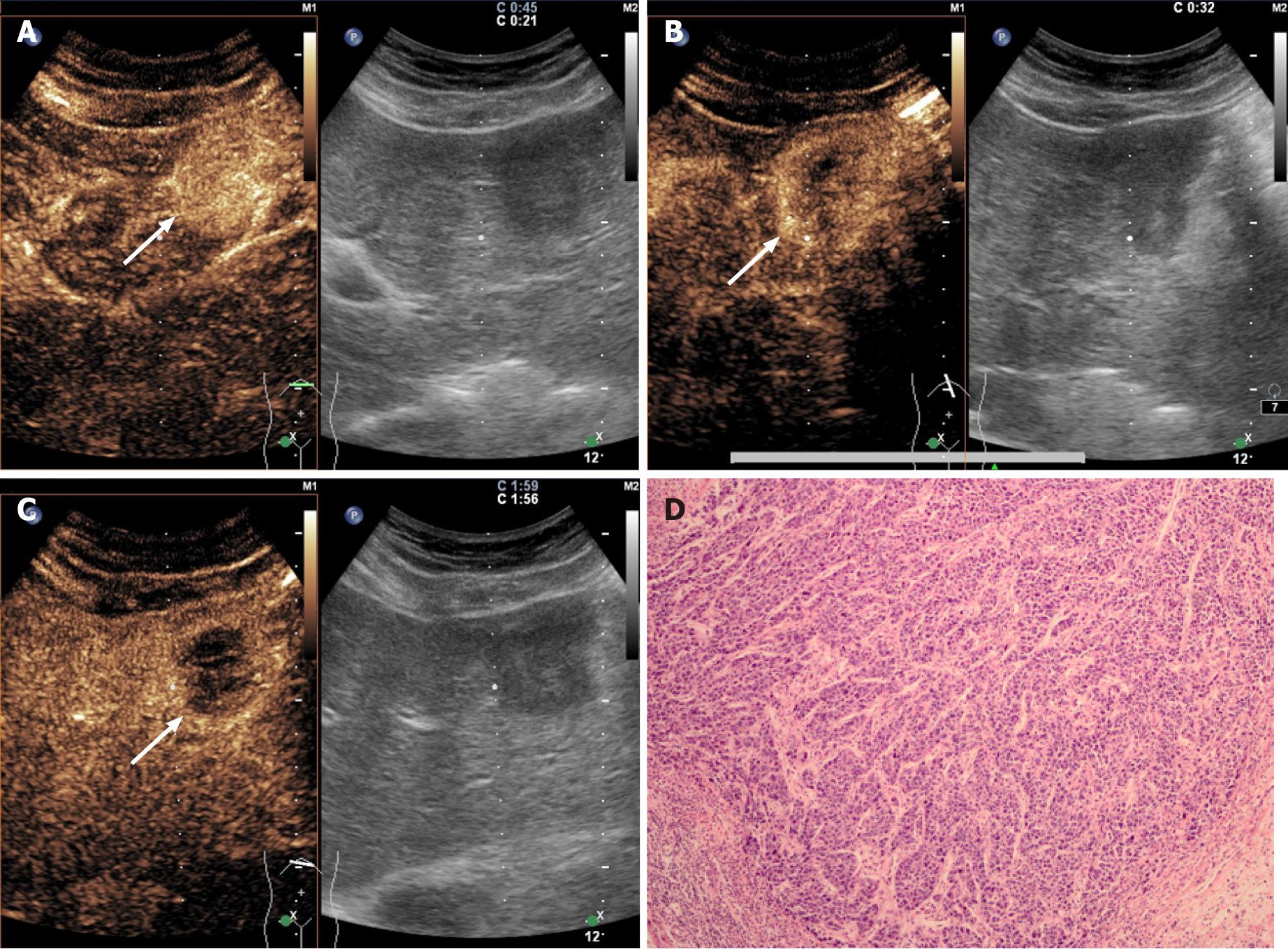Copyright
©The Author(s) 2020.
World J Gastroenterol. Dec 14, 2020; 26(46): 7325-7337
Published online Dec 14, 2020. doi: 10.3748/wjg.v26.i46.7325
Published online Dec 14, 2020. doi: 10.3748/wjg.v26.i46.7325
Figure 1 Study population selection flowchart.
AFP: Alpha-fetoprotein; CA19-9: Carbohydrate antigen 19-9; CEUS: Contrast-enhanced ultrasound; CHC: Combined hepatocellular-cholangiocarcinoma; HCC: Hepatocellular carcinoma; ICC: Intrahepatic cholangiocarcinoma.
Figure 2 LR-M nodule in a 54-year-old man with chronic hepatitis B.
A: A nodule with a diameter of 3.6 cm in the right liver lobe was homogeneously hyper-enhanced (arrow) in the arterial phase at contrast-enhanced ultrasound; B: Early washout (53 s) of the contrast agent was observed (arrow); C: Hypo-enhancement (arrow) in the late phase was shown at contrast-enhanced ultrasonography. Elevated alpha-fetoprotein and normal carbohydrate antigen 19-9 level were found by in the serologic data. The nodule was assigned to combined hepatocellular-cholangiocarcinoma lesion according to the diagnostic criteria; D: Both hepatocellular carcinoma (orange arrow) and intrahepatic cholangiocarcinoma (yellow arrow) components were found in histopathologic analysis, resulting in a final diagnosis of combined hepatocellular-cholangiocarcinoma (hematoxylin and eosin staining; magnification, × 100).
Figure 3 LR-M nodule in a 55-year-old woman with chronic hepatitis B.
A: A hypoechoic nodule with a diameter of 3.4 cm in the left lobe of the liver was homogeneously hyper-enhanced (arrow) in the arterial phase; B: Early washout was observed at 32 s after injection of contrast agent (SonoVue; Bracco); C: Hypo-enhancement of the whole nodule was demonstrated in the late phase. Serologic data indicated normal alpha-fetoprotein and carbohydrate antigen 19-9 levels. The nodule was assessed as non-combined hepatocellular-cholangiocarcinoma lesion according to the diagnostic criteria; D: The nodule was proved to be hepatocellular carcinoma by pathology (hematoxylin and eosin staining; magnification, × 100).
Figure 4 LR-M nodule in a 46-year-old man with chronic hepatitis B.
A: A hypoechoic nodule with a diameter of 3.9 cm in the right lobe of the liver was heterogeneously hyper-enhanced (arrow) in the arterial phase; B: Early washout (30 s) of the contrast agent was observed (arrow); C: Hypo-enhancement of the nodule (arrow) in the late phase was shown at contrast-enhanced ultrasound. The patient had both normal alpha-fetoprotein and carbohydrate antigen 19-9 levels. The lesion was classified as non-combined hepatocellular-cholangiocarcinoma lesion according to the diagnostic criteria; D: Intrahepatic cholangiocarcinoma and cirrhosis of the surrounding liver were confirmed by pathology (hematoxylin and eosin staining; magnification, × 100).
- Citation: Yang J, Zhang YH, Li JW, Shi YY, Huang JY, Luo Y, Liu JB, Lu Q. Contrast-enhanced ultrasound in association with serum biomarkers for differentiating combined hepatocellular-cholangiocarcinoma from hepatocellular carcinoma and intrahepatic cholangiocarcinoma. World J Gastroenterol 2020; 26(46): 7325-7337
- URL: https://www.wjgnet.com/1007-9327/full/v26/i46/7325.htm
- DOI: https://dx.doi.org/10.3748/wjg.v26.i46.7325












